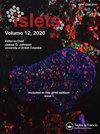小鼠和人胰岛在皮下无装置部位移植的长期功能和优化
IF 1.9
4区 医学
Q3 ENDOCRINOLOGY & METABOLISM
引用次数: 22
摘要
临床胰岛移植已被证明是恢复自身免疫性糖尿病患者血糖控制的有效手段。尽管取得了显著的进展和改善,但由于肝内门静脉细胞输注相关的并发症和人类供体胰腺的稀缺性,这种治疗方案的广谱应用受到限制。干细胞生物学的最新进展表明,扩大用于临床移植的新β细胞的潜力现在已经成为现实。因此,研究的重点是优化安全的肝外移植部位,以安置未来临床使用的替代β细胞来源。目前的研究扩展了我们之前开发的用于细胞移植的血管前化皮下无装置(DL)技术,通过证明长期(>365 d)持久的同基因小鼠胰岛移植功能。此外,对dl位点建立后和急性胰岛移植后立即收集的组织标本进行组织学分析表明,该技术可使新生血管化的胶原与移植细胞紧密结合,无死腔,从而避免了缺氧的管腔死腔。将小鼠胰岛移植到更大的管径(6-Fr.)产生的DL部位(n = 11),将糖尿病逆转到与我们的标准DL方法(5-Fr.)相似的容量(n = 9)。此外,糖耐量测试在这两个移植组之间没有差异(p >0 0.05)。综上所述,DL移植方法的进一步改进有助于简化胰岛输注方法,增加移植体积容量,并可能为未来替代β细胞来源提供有效的微环境。本文章由计算机程序翻译,如有差异,请以英文原文为准。
Long-term function and optimization of mouse and human islet transplantation in the subcutaneous device-less site
ABSTRACT Clinical islet transplantation has routinely been demonstrated to be an efficacious means of restoring glycemic control in select patients with autoimmune diabetes. Notwithstanding marked progress and improvements, the broad-spectrum application of this treatment option is restricted by the complications associated with intrahepatic portal cellular infusion and the scarcity of human donor pancreata. Recent progress in stem cell biology has demonstrated that the potential to expand new β cells for clinical transplantation is now a reality. As such, research focus is being directed toward optimizing safe extrahepatic transplant sites to house future alternative β cell sources for clinical use. The present study expands on our previous development of a prevascularized subcutaneous device-less (DL) technique for cellular transplantation, by demonstrating long-term (>365 d) durable syngeneic murine islet graft function. Furthermore, histological analysis of tissue specimens collected immediately post-DL site creation and acutely post-human islet transplantation demonstrates that this technique results in close apposition of the neovascularized collagen to the transplanted cells without dead space, thereby avoiding hypoxic luminal dead-space. Murine islets transplanted into the DL site created by a larger luminal diameter (6-Fr.) (n = 11), reversed diabetes to the similar capacity as our standard DL method (5-Fr.)(n = 9). Furthermore, glucose tolerance testing did not differ between these 2 transplant groups (p > 0 .05). Taken together, this further refinement of the DL transplant approach facilitates a simplistic means of islet infusion, increases the transplant volume capacity and may provide an effective microenvironment to house future alternative β cell sources.
求助全文
通过发布文献求助,成功后即可免费获取论文全文。
去求助
来源期刊

Islets
ENDOCRINOLOGY & METABOLISM-
CiteScore
3.30
自引率
4.50%
发文量
10
审稿时长
>12 weeks
期刊介绍:
Islets is the first international, peer-reviewed research journal dedicated to islet biology. Islets publishes high-quality clinical and experimental research into the physiology and pathology of the islets of Langerhans. In addition to original research manuscripts, Islets is the leading source for cutting-edge Perspectives, Reviews and Commentaries.
Our goal is to foster communication and a rapid exchange of information through timely publication of important results using print as well as electronic formats.
 求助内容:
求助内容: 应助结果提醒方式:
应助结果提醒方式:


